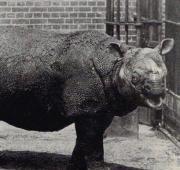 The Javan Rhino primarily inhabits dense lowland rain forests, tall grass and reed beds that are plentiful with rivers, large floodplains, or wet areas with many mud wallows. The range of Javan rhinoceros once stretched from Bengal, through south-east Asia and down to Sumatra but today, the Javan rhinoceros is only found in Vietnam and on the island of Java.
The Javan Rhino primarily inhabits dense lowland rain forests, tall grass and reed beds that are plentiful with rivers, large floodplains, or wet areas with many mud wallows. The range of Javan rhinoceros once stretched from Bengal, through south-east Asia and down to Sumatra but today, the Javan rhinoceros is only found in Vietnam and on the island of Java.
The Javan rhinoceros only has one horn which is much smaller than those of other rhinoceros species, growing to an average length of 25cm. The Javan rhinoceros uses its small horn for defence, intimidation, digging up roots and breaking branches during feeding. The horn of the Javan rhinoceros is made from a substance called keratin and is therefore very strong. The horn of the Javan rhinoceros is used in ancient medicine and many Indian rhinos have been illegally poached for them.
The Javan rhinoceros has relatively poor eyesight, relying more on hearing and smell to detect what is going on around them. The ears of the Javan rhinoceros possess a relatively wide rotational range to detect sounds and an excellent sense of smell to readily alert them to the presence of predators.
The Javan rhinoceros is a herbivorous animal meaning that it sustains itself on a purely plant based diet. Javan rhinos browse the densely vegetated sub-tropical forest for leaves, flowers, buds, fruits, berries and roots which they dig up from the ground using their horns.
Due to it's large size, the Javan rhino's only real predator in the wild are large wild cats such as tigers that will prey on the Javan rhino calves and weak individuals. Humans are the biggest threat to the Javan rhinoceros as they have been hunted to the brink of extinction for their horns.
The Javan rhinoceros is solitary animal and only comes together with other Javan rhinos to mate. The female Javan rhinoceros gives birth to a single calf after a gestation period that is over a year long. The Javan rhinoceros calf remains with it's mother until it is at least 2 years old and big enough to become independent.
Today, the Javan rhinoceros has been poached for it's horns to the extent that it is on the brink of extinction. Hunting of the Javan rhinoceros along with habitat loss in their native regions have led to there being only a handful of Javan rhinoceros individuals left in the jungles of south-east Asia today.

